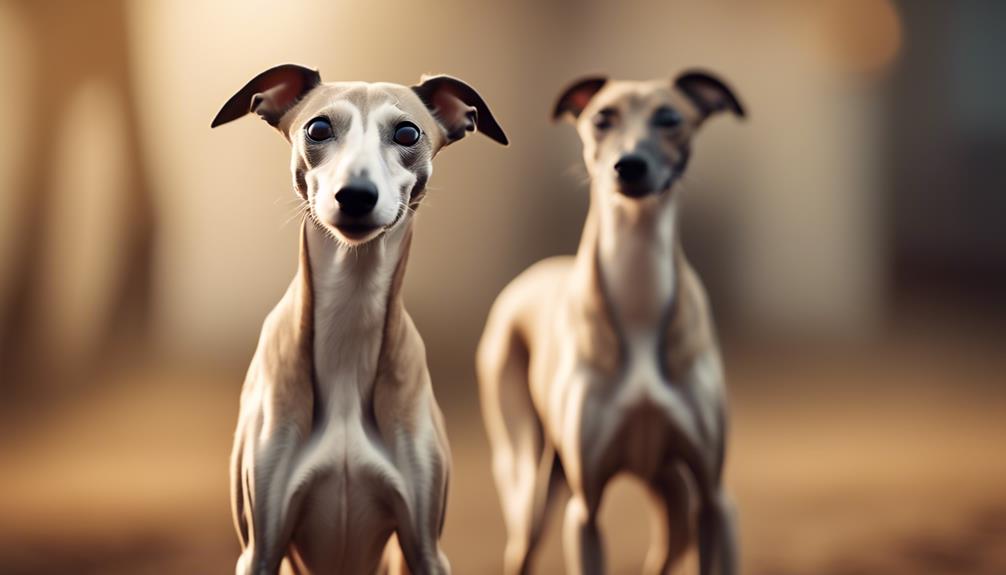
Are Whippets really the perfect breed for you? Well, let’s take a closer look at their unique characteristics and find out.
From their elegant physique to their amiable nature, there’s a lot to discover about these delightful dogs.
But that’s not all – we’ll also explore their health, exercise needs, and how they interact with children and other pets.
So, if you’re curious to uncover the secrets of the Whippet breed, stick around and prepare to be amazed.
Key Takeaways
- Whippets are medium-sized dogs with a short, smooth coat that can come in various colors.
- They have a friendly and gentle personality at home, but can be intense in the chase and require a leash or fenced yard to prevent chasing.
- Whippets are generally a healthy breed, but it is important to buy from a responsible breeder and obtain health clearances for genetic diseases.
- They adapt well to apartment living and are good for novice owners, but they still require daily exercise and mental stimulation.
Origin and History
The Whippet breed originated in England and has a rich history. These elegant dogs were developed in the mid-19th century by crossing small Greyhounds with various terrier breeds. The goal was to create a fast and agile dog for racing and hunting small game. Whippets quickly gained popularity among working-class families as well as nobility. They were used for racing, coursing, and even ratting.
In the early 20th century, Whippet racing became a popular sport in England, and these dogs were known as ‘the poor man’s racehorse.’ Today, Whippets are beloved companions and successful show dogs. They’re known for their grace, speed, and gentle nature. Whippets continue to excel in lure coursing, agility, and obedience competitions.
See another Dog breed profile.
Whoodle Mixed Dog Breed
Size and Weight

When considering the size and weight of Whippets, it’s important to note their medium stature and lean build. Whippets aren’t too big or too small, making them a perfect size for many households.
Here are three reasons why their size and weight are appealing:
- Their medium size allows them to adapt well to apartment living, making them suitable for those with limited space.
- Whippets aren’t too heavy or bulky, making them easy to handle and cuddle with.
- Their lean build enables them to be agile and fast, perfect for athletic activities and sports.
Coat and Colors
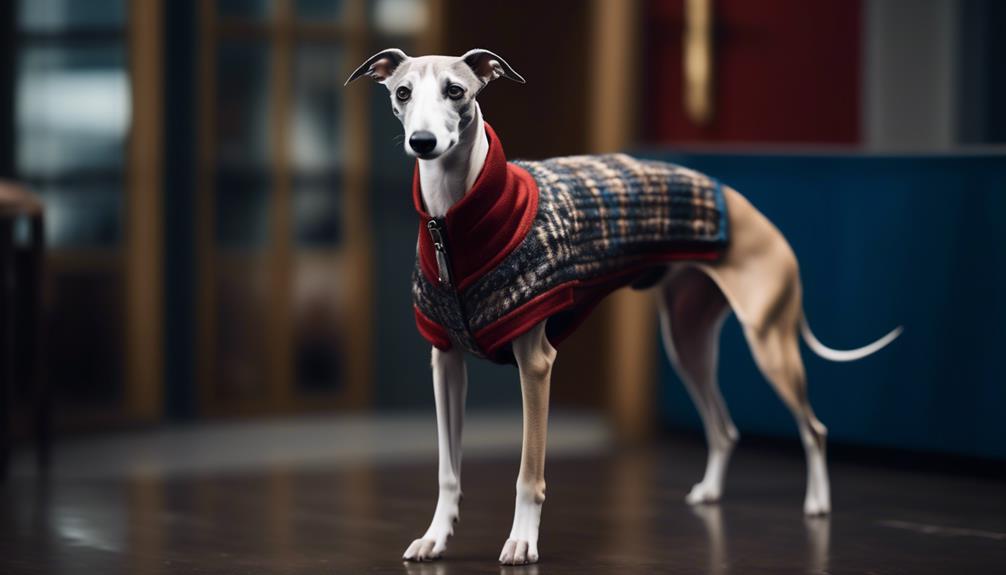
Whippets have a variety of coat colors and patterns, adding to their unique and eye-catching appearance. Their short, smooth coat can come in various colors, including black, white, red, fawn, blue, cream, and brindle. The coat may have spots, blazes, and patches, creating a beautiful and distinct look.
Whippets are known for their sleek and elegant appearance, which is further enhanced by their coat colors and patterns. Whether you prefer a solid-colored Whippet or one with a combination of colors, you can find a coat that suits your taste.
Additionally, Whippets shed very little, making them a low-maintenance breed when it comes to grooming. With their stunning coat colors and patterns, Whippets are sure to turn heads wherever they go.
Personality and Temperament
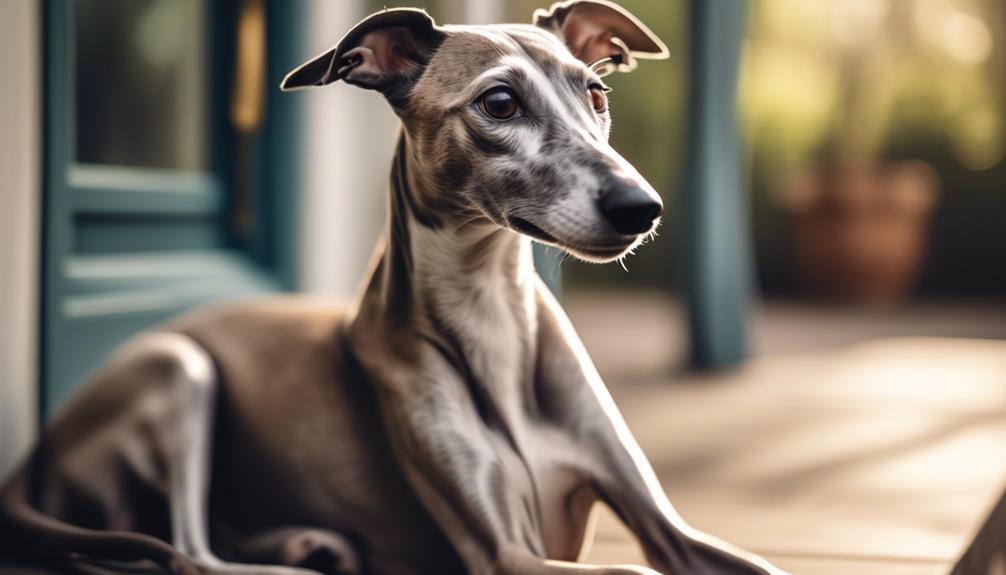
With their amiable and gentle nature, Whippets make wonderful companions for individuals and families alike. Their personality and temperament are truly endearing, making them a joy to be around. Here are three characteristics that make Whippets so special:
- Affectionate: Whippets are incredibly loving and enjoy being close to their owners. They thrive on affection and are known for their gentle and sweet nature.
- Playful: Despite their calm demeanor, Whippets have a playful side. They love to engage in interactive playtime and enjoy chasing after toys or playing games with their family members.
- Easygoing: Whippets are known for their laid-back attitude. They’re generally easy to train and are adaptable to different environments. Their relaxed nature makes them great companions for people of all ages.
These qualities make Whippets not only a great addition to any home but also a wonderful source of happiness and companionship.
Lifespan and Health
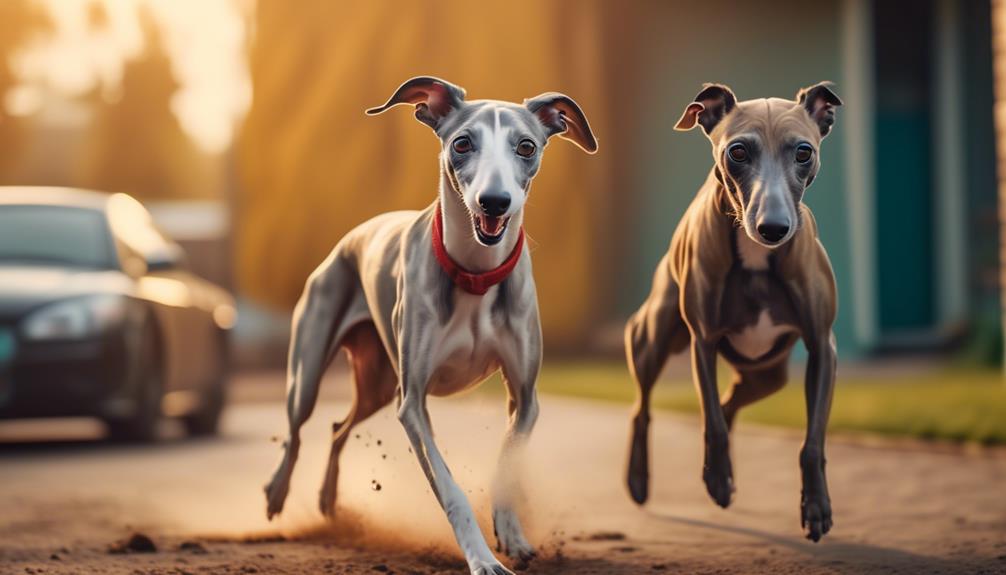
To understand the lifespan and health of Whippets, it’s important to consider their overall well-being and potential medical concerns. Whippets have a relatively long lifespan of 12 to 15 years, which is great news for potential owners looking for a long-term companion. However, like any breed, they may be prone to certain health issues. Table 1 below provides a summary of the common health conditions that Whippets may experience. It’s important to note that responsible breeders often conduct health clearances and genetic testing to ensure healthier puppies. Additionally, regular veterinary check-ups and a well-balanced diet are essential for maintaining the overall health of your Whippet.
Table 1: Common Health Conditions in Whippets
| Health Condition | Description |
|---|---|
| Arrhythmia | Irregular heart rhythm |
| Progressive Retinal Atrophy (PRA) | Degenerative eye disease leading to blindness |
| Hip Dysplasia | Abnormal hip joint development |
| Bloat | Life-threatening condition causing gas buildup |
Care and Exercise Requirements

To ensure the well-being and vitality of your Whippet, it’s important to provide proper care and fulfill their exercise requirements. Whippets are active dogs that require regular physical activity to stay healthy and happy. Here are three key points to consider:
- Daily exercise: Whippets have a lot of energy and need daily exercise to prevent boredom and behavior problems. Provide them with regular walks, runs in a fenced area, and playtime to keep them physically and mentally stimulated.
- Off-leash runs: Whippets are known for their incredible speed and love for running. Giving them the opportunity to run off-leash in a safe and secure environment, such as a fenced yard or a dog park, allows them to stretch their legs and satisfy their natural instinct to chase.
- Mental stimulation: In addition to physical exercise, Whippets also benefit from mental stimulation. Engage their minds with puzzle toys, obedience training, and interactive games to keep them mentally sharp and prevent boredom.
Feeding and Nutrition

Now let’s shift our focus to the important aspect of caring for your Whippet: their feeding and nutrition needs.
It’s crucial to provide your Whippet with a balanced and nutritious diet to support their overall health and well-being.
The recommended daily amount of food for a Whippet is 1 to 1.5 cups of high-quality dry food, divided into two feedings. However, the exact amount of food your Whippet needs will depend on factors such as their size, age, metabolism, and activity level.
Highly active Whippets may require more food than sedentary ones.
It’s also essential to choose a high-quality dog food that provides all the necessary nutrients for your Whippet’s optimal health.
Remember to maintain a consistent and regular feeding schedule to keep your Whippet healthy and satisfied.
Adaptability to Different Living Situations

Considering the adaptability of the Whippet breed to different living situations, it’s important to evaluate their size, energy levels, and behavior.
Whippets are medium-sized dogs, making them suitable for both apartments and houses. They’ve moderate energy levels, which means they can adapt to a variety of living environments.
Their calm and gentle nature also makes them well-suited for apartment living. Additionally, Whippets are known for being quiet and well-behaved, making them ideal for those living in noise-restricted areas.
Their adaptability to different living situations ensures that they can thrive in various environments, bringing joy and companionship to their owners.
Aggression, Fear, and Barking Tendency

Aggression in Whippets, like in all dogs, is often rooted in fear and anxiety. It is important to understand that fear-based aggression can lead to dangerous situations for both dogs and humans. When choosing a dog breed, it is crucial to consider their barking tendencies. Hounds, in particular, are known for their howling tendencies. Living in a noise-restricted area may require a quieter dog breed. To provide a more comprehensive understanding, here is a table that showcases the barking tendencies of different dog breeds:
| Breed | Barking Tendency |
|---|---|
| Whippet | Low |
| Beagle | High |
| Shih Tzu | Low |
Wanderlust Potential and Exercise Needs

Understanding the exercise needs and wanderlust potential of different dog breeds is crucial when considering the right fit for your lifestyle and home environment.
When it comes to wanderlust potential, certain breeds have a higher tendency to wander off, which can lead to dangerous situations for dogs. Nordic dogs, like Siberian Huskies, have a strong instinct to roam, while hounds often follow their noses and may chase after animals. Lack of proper control can put your furry friend at risk.
On the other hand, dogs have different energy levels and exercise requirements. High-energy dogs need plenty of exercise and mental stimulation, while low-energy dogs are more content with a sedentary lifestyle. Consider your own activity level when choosing a breed, as certain breeds require vigorous exercise due to their working or hunting backgrounds.
Potential for Playfulness and Interaction With Children
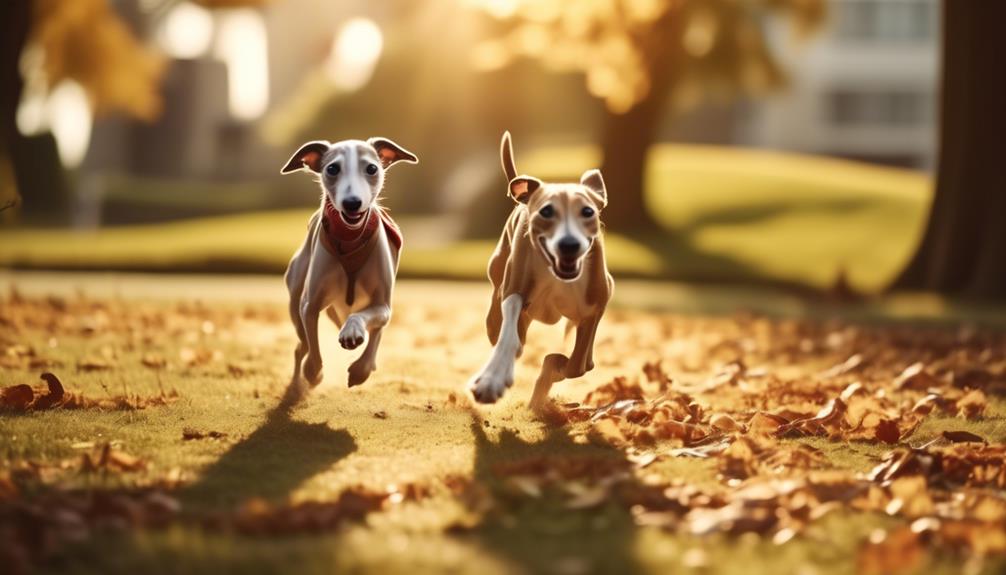
Whippets are known for their playful nature and excellent interaction with children. They enjoy playing and aren’t easily knocked over or injured, making them a great choice for families with kids.
It’s important to teach children how to approach and touch dogs properly, and to supervise their interactions to prevent any biting or pulling. Remember to never disturb a dog while they’re sleeping or eating.
Whippets can also get along well with other dogs, but they may not be suitable for homes with cats due to their prey drive.
Grooming and Interaction With Other Pets
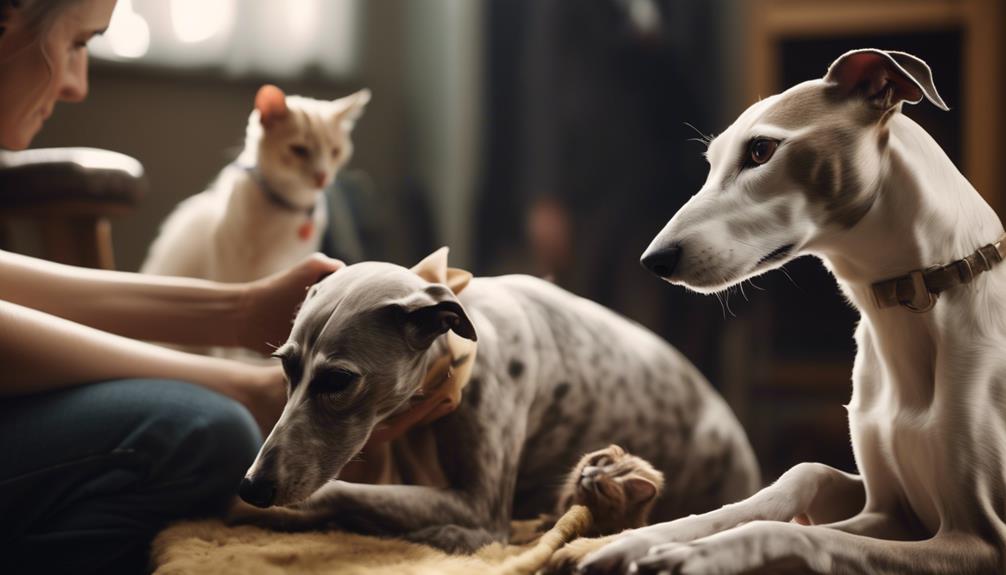
When it comes to grooming and interacting with other pets, Whippets are relatively low-maintenance and can be compatible with certain animals. Here are a few things to keep in mind:
- Whippets have a short, smooth coat that lies close to the body, making them easy to groom. A weekly brushing with a rubber curry brush or hound glove will help maintain a shiny coat. Plus, they shed very little, which means less time spent cleaning up hair.
- Whippets enjoy playing with kids and are generally gentle and patient. They aren’t easily knocked over or injured, making them a great choice for families with young children.
- While Whippets can get along with other dogs, they may not be suitable for homes with cats due to their prey drive. It’s important to carefully introduce them to other pets and supervise their interactions to ensure everyone’s safety.
Frequently Asked Questions
Are Whippets Good With Children?
Yes, Whippets are good with children. They enjoy playing with kids and are gentle and unlikely to knock them over or cause injury. However, always supervise interactions to prevent any biting or pulling.
Do Whippets Shed a Lot?
No, Whippets do not shed a lot. Their short, smooth coat requires weekly brushing to maintain a shiny appearance. They are a low-shedding breed, making them a good choice for individuals with allergies or those who prefer a cleaner home.
Can Whippets Be Left Alone for Long Periods of Time?
Yes, Whippets can be left alone for moderate periods of time. However, they are social dogs and may become anxious if left alone for extended periods. It’s important to provide mental stimulation and exercise before leaving them alone.
Are Whippets Prone to Aggression?
Whippets are generally not prone to aggression. However, like any dog, individual temperament may vary. Proper socialization, training, and a loving environment can help ensure that your Whippet is friendly and well-behaved.
How Often Should Whippets Be Groomed?
Whippets should be groomed regularly to maintain their short, smooth coat. A weekly brushing using a rubber curry brush or hound glove is recommended to keep their coat shiny. Whippets shed very little.
Conclusion
In conclusion, Whippets are a wonderful choice for those looking for a friendly and amiable companion. With their lean and elegant physique, they make for a graceful addition to any home.
While their intense chase instinct requires caution, their alertness and adaptability make them great watchdogs.
With proper care and exercise, Whippets can live a healthy and happy life, bringing joy to their owners and interacting well with children and other pets.
Consider adding a Whippet to your family today!




